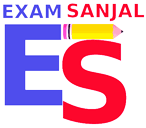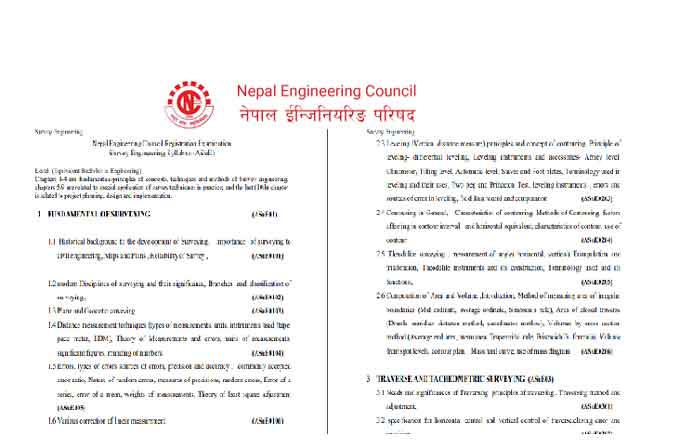Nepal Engineering Council Name Registration Exam Syllabus. View Engineering Council Parishad Name Register Exam Syllabus. Nepal Engineering Council License examination Syllabus Model questions Details. Engineering Council, Survey Engineering Name Register Exam Syllabus. Nepal Engineering Council Registration Examination. Welcome to Nepal Engineering Counicl Name Register Syllabus Pathyakram for General Engineer Registration Exam.
Application form for exam can be applied online who have completed their Bachelor’s Degree in Engineering from the universities recognized by Nepal Engineering Council.
To check your university click on the link Check Universities. NOTE: If you do not find your university, your university may not yet be recognized by NEC. Please, Kindly visit NEC Office for further information.
Nepal Engineering Council License Exam Name Register Exam Fee Details
B. Fee Information
Exam Fee – Rs.2,500/-(to be deposited at the time of online application)
Candidates who had paid Rs 3500/- at chaitra exam 2079-12-12/13 has been adjusted Rs 1000/- and they have to pay Rs 1500/- only when they reapply for exam.
Registration Fee: Rs 5000/- + Id card charges Rs. 200/-.
Total Rs 5,200/- (to be deposited at NEC Account, After passing the exam)
For adjustment of Rs 1000/- in exam fee who had paid Rs 3500/- for chaitra exam 2079-12-12/13, have to pay Rs 4200/- only for registration fee.
Please upload your bank voucher online, then provide a hard copy of bank voucher or khalti payment to NEC
Nepal Engineering Council License Exam Name Register Exam Online Application process
Reapply:
The candidate who had already appeared the NEC exam, they can only reapply from their Dashboard by doing payment only, they need not to submit new application.
Online Payment Provision:
The Candidate who wants to pay online, a gateway of payment Khalti is available at the end, while filling out the online application form.
Offline Payment Provision:
The applicant should deposit fee in the name of Nepal Engineering Council, Account No. 1160100001093001 at any branches of Rastriya Banijya Bank. Bank voucher must be upload in the online application system.
Nepal Engineering Council License Exam Name Register Exam Required Documents
C. Required Documents (Notarized copy of all the document must be uploaded.)
Nepalese Citizenship Certificate
Mark Sheet of SEE
Character Certificate of SEE
Transcript of 10+2
Character Certificate of 10+2
Transcript / Semester wise mark sheet of the Bachelor’s degree.
Character certificate of the Bachelor’s degree/ Documents showing duration of study.
Degree / Provisional certificate of bachelor’s degree issued by university.
Equivalance certificate from authorized agency of nepal government is required for student studied from abroad for SEE, 10+2 or Bachelor (If applicable)
NEC Registration Certificates of two registered engineer.(Notary not necessary)
One Passport size photo.
Note:- Application can be submitted online only no need to submit hardcopy to NEC
Nepal Engineering Council License Exam Syllabus of Survey Engineering Syllabus (ASuE)
Level: (Equivalent Bachelor in Engineering)
Chapters 1-4 are fundamentals/principles of concepts, techniques and methods of Survey engineering;
chapters 5-9 are related to special application of survey techniques in practice; and the last (10th) chapter is related to project planning, design and implementation.
1 FUNDAMENTAL OF SURVEYING (ASuE01)
1.1 Historical background to the development of Surveying, importance of surveying to civil engineering, Maps and Plans , Reliability of Survey , (ASuE0101)
1.2 modern Disciplines of surveying and their significance, Branches and classification of surveying , (ASuE0102)
1.3 Plane and Geodetic surveying (ASuE0103)
1.4 Distance measurement techniques (types of measurements, units, instruments used (tape, pace meter, EDM), Theory of Measurements and errors, units of measurements, significant figures, rounding of numbers. (ASuE0104)
1.5 Errors, types of errors sources of errors, precision and accuracy , commonly accepted error ratio, Nature of random errors, measures of precisions, random errors, Error of a series, error of a mean, weights of measurements, Theory of least square adjustment. (ASuE105)
1.6 Various correction of linear measurement (ASuE0106)
2 SURVEYING METHODS (ASuE02)
2.1 Introduction of traditional survey ,Chain survey, Compass survey, Plane-table survey, (angular measurement and traversing) (ASuE0201)
2.2 Coordinate system , bearings, horizontal control, traversing, and triangulation (ASuE0202)
2.3 Leveling (Vertical distance measure) principles and concept of contouring ,Principle of leveling- differential leveling, Leveling instruments and accessories- Abney level, Clinometer, Tilting level, Automatic level, Staves and Foot plates, Terminology used in leveling and their uses, Two peg and Princeton Test. leveling instruments , errors and sources of error in leveling, field data record and computation (ASuE0203)
2.4 Contouring in General, Characteristics of contouring, Methods of Contouring, factors affecting in contour interval, and horizontal equivalent, characteristics of contour, use of contour (ASuE0204)
2.5 Theodolite surveying , measurement of angle( horizontal, vertical) Triangulation and trilateration, Theodolite instruments and its construction, Terminology used and its functions, (ASuE0205)
2.6 Computation of Area and Volume ,Introduction, Method of measuring area of irregular boundaries (Mid ordinate, average ordinate, Simpson’s rule), Area of closed traverse (Double meridian distance method, coordinates method), Volumes by cross section method (Average end area, mean area, Trapezoidal rule, Prismoidal’s formula), Volume from spot levels, contour plan, Mass haul curve, use of mass diagram (ASuE0206)
3 TRAVERSE AND TACHEOMETRIC SURVEYING (ASuE03)
3.1 Needs and significances of Traversing principles of traversing , Traversing method and adjustment, (ASuE0301)
3.2 specification for horizontal control and vertical control of traverse,closing error and precision , (ASuE0302)
3.3 Booking and computation of traverse ,reduction of reading to angle and bearing , angle distances relationship in traversing, adjustment of angle and bearing, (ASuE0303)
3.4 Computation of latitudes and departures ,balancing the traverse, Sources of errors and adjustment , traverse omitted measurement ,independent coordinate (ASuE0304)
3.5 Basic principle of tacheometry, principle of optical distance measurement derivation tacheometry formula and different method of tacheometry and tachometric, (ASuE0305)
3.6 Stadia methods tangential method, subtense bar booking and computation of tachometric field data and map preparation (ASuE0306)
4 TRIGONOMETRIC LEVELING, ORIENTATION AND PHOTOGRAMMETRY (ASuE04)
4.1 Determination of height and distance of object (accessible and inaccessible),(ASuE0401)
4.2 Reciprocal trigonometric leveling (ASuE0402)
4.3 Introduction of orientation, its uses, Analytical intersection (F- 45 degree , Collins method) (ASuE0403)
4.4 Resection: Two point problem and three point problem, and their significance (ASuE0404)
4.5 Introduction of photogrammetry and remote sensing, scale of vertical photograph, relief displacement , electromagnetic radiation (ASuE0405)
4.6 Uses of remote sensing in engineering, merit, limitation and advantages of Photogrammetry and remote sensing (ASuE0406)
5 . TRIANGULATION AND TRILATERATION (ASuE05)
5.1 Introduction, Accuracy of horizontal control systems, (ASuE0501)
5.2 Triangulation figures; Choice of figures; Triangulation procedure, Angle and side
conditions; error propagation in triangulation; strength of figure in triangulation; base line (ASuE0502)
5.3 Triangulation computations; Adjustment of triangulation, (ASuE0503)
5.4 Trilateration; adjustment of trilateration (ASuE0504)
5.5 Combined triangulation and trilateration (ASuE0505)
5.6 First and second geodetic problem on the plane, trig sections, station and target eccentricities (ASuE0506)
6 CURVES, CURVES SETTING OUT AND CURVE RANGING (ASuE06)
6.1 Types of curve, Method of horizontal curve layout, computation of elements of curve,
calculation and setting out of circular curves, transition curves (Simple circular, transition curves by different linear and angular method (ASuE0601)
6.2 Geometry of transition curves , computation (ASuE0602)
6.3 Horizontal control, Vertical control, vertical alignment (ASuE0603)
6.4 Elements of composite curves and setting out technique (ASuE0604)
6.5 Concept of grades and Vertical curves (ASuE0605)
6.6 Computation and staking of vertical curve, reduce level of points on curves (ASuE0606)
7 FIELD ASTRONOMY, GPS AND GIS ASuE07)
7.1 Introduction : geographic coordinate system, use of astronomy in surveying and mapping, Purposes, Astronomical terms Latitude and Longitude, Spherical Trigonometry Celestial coordinate system, Determination of Azimuths, determination latitude and longitude,time and azimuth (ASuE0701)
7.2 Electronic Distance Measurement, Classification of EDM instruments, Principle of EDM,Microwave, electro-optical instruments (ASuE0702)
7.3 Total station, Features of total station, Total station operation and data download,Errors in electronic distance measurement (ASuE0703)
7.4 Introduction to global position system ( GPS), components of GPS, working principles of GPS, differential positioning system (ASuE0704)
7.5 Introduction and components of geographical information system ( GIS), uses of GIS (ASuE0705)
7.6 Use of survey software in data analysis and mapping (ASuE0706)
8 HYDROGRAPHIC SURVEY (ASuE08)
8.1 Introduction, importance and needs of hydrographic survey, purpose of hydrographic surveys (ASuE0801)
8.2 Vertical control , Horizontal control, framework (ASuE0802)
8.3 measurement of cross section , velocity of flow, and depth and discharge Controlling vessel position, Use of different instrument (current meter, ) (ASuE0803)
8.4 Electronic positioning, Computation of position (Echo sounding , sounding rods, and cables) (ASuE0804)
8.5 Accuracy of positions (ASuE0805)
8.6 Depth determination, ship borne echo- sounding and mechanical methods, airborne laser and electromagnetic methods, related corrections (ASuE0806)
9 CONSTRUCTION SURVEYING AND SETTING OUT (ASuE09)
9.1 Introduction, Equipment for setting out, Horizontal and vertical control (ASuE0901)
9.2 Setting out of land plot, building and structures (ASuE0902)
9.3 Setting out a pipe line, laying pipe line through laser (ASuE0903)
9.4 Setting out transmission line, cable work (ASuE0904)
9.5 Setting out highway, bridge , culvert (ASuE0905)
9.6 Connection of surface and underground lines (Tunnel layout) (ASuE0906)
10. Project Planning, Design and Implementation (AALL10)
10 10.1 Engineering drawings and its concepts: Fundamentals of standard drawing sheets, dimensions, scale, line diagram, orthographic projection, isometric projection/view, pictorial views, and sectional drawing. (AALL1001)
11 10.2 Engineering Economics: understanding of project cash flow; discount rate, interest and time value of money; basic methodologies for engineering economics analysis (Discounted Payback Period, NPV, IRR & MARR); comparison of alternatives, depreciation system and taxation system in Nepal. (AALL1002)
12 10.3 Project planning and scheduling: project classifications; project life cycle phases; project planning process; project scheduling (bar chart, CPM, PERT); resources levelling and smoothing; monitoring/evaluation/controlling. (AALL1003)
13 10.4 Project management: Information system; project risk analysis and management; project financing, tender and its process, and contract management. (AALL1004)
14 10.5 Engineering professional practice: Environment and society; professional ethics; regulatory environment; contemporary issues/problems in engineering; occupational health and safety; roles/responsibilities of Nepal Engineers Association (NEA). (AALL1005)
15 10.6 Engineering Regulatory Body: Nepal Engineering Council (Acts & Regulations). (AALL1006)
=> Click Here To Apply Online Application for Nepal Engineering Council License Exam
=> Click Here to View download Nepal Engineering Council Syllabus
Also view:
1. View All Job Vacancy Notice Details
2. View All TU Exam Result Center Update
3. View All Lok Sewa Exam Vacancy Tayari

